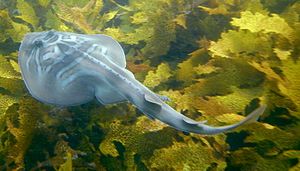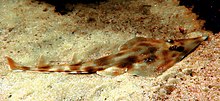Trygonorrhinidae
| Trygonorrhinidae | ||||||||||||
|---|---|---|---|---|---|---|---|---|---|---|---|---|

Trygonorrhina fasciata |
||||||||||||
| Systematics | ||||||||||||
|
||||||||||||
| Scientific name | ||||||||||||
| Trygonorrhinidae | ||||||||||||
| Last , Séret & Naylor , 2016 |
The Trygonorrhinidae are a family of rays (Batoidea) introduced in mid-2016 . The family includes three genera with a total of eight species from the group of so-called violin or guitar rays.
features
The Trygonorrhinidae species are small to medium-sized rays with a maximum length of 1.5 meters. Like all violin rays, their body shape mediates between the sharks and the typical rays or stingray-like . Your body disc is wide and approximately oval ( Trygonorrhina and Zapteryx ) or wedge-shaped ( Aptychotrema ), the trunk is relatively narrow and flattened. The rostrum is very long and pointed or short and rounded. The eyes and injection hole are small to medium-sized, in Trygonorrhina the injection hole has a distinct skin flap, which in Aptychotrema and Zapteryx is only slightly developed or is completely absent. The nostrils are small and more horizontal than oblique. In front of the nostrils there are differently formed membranous, bilobed nasal lobes with a long base. The mouth is straight or strongly curved.
The skin is covered with small to thick placoid scales. A row of medium-sized to very large thorns runs along the center line of the back. Small fields of enlarged thorns lie near the eyes and on the "shoulders". The tail has a well-developed fold of skin on both sides. Both unite ventrally at the caudal fin base immediately in front of the small caudal fin lobe. The pelvic fins lie behind the body disc and can have a short or long base. The two dorsal fins are clearly separated from each other, the first is a little behind the rear tips of the pelvic fins.
The Trygonorrhinidae often show a conspicuous drawing consisting of narrow and wide lines and spots on their upper side. The edges of the skull and the cartilage of the rostrum are not sharply delineated from the muzzle. The ventral side is mainly white, black spots are sometimes present on the underside of the snout and the posterior disc.
The three species of the genus Aptychotrema with their wedge-shaped body are very similar to the fiddle rays of the family Rhinobatidae , but differ from these by the more curved mouth and the missing or only weakly developed skin flaps at the injection holes.
Systematics
The Trygonorrhinidae differ significantly from other violin and guitar rays in all molecular genetic studies. With Last and colleagues they occupy a basic position within the Rhinopristiformes as sister group of all other families, with Aschliman and coworkers they are the sister group of the Rhinopristiformes and the Myliobatiformes .
Genera and species
- Genus Aptychotrema
- Aptychotrema rostrata (Shaw, 1794)
- Aptychotrema timorensis Last, 2004
- Aptychotrema vincentiana (Haacke, 1885)
- Genus Trygonorrhina (type genus)
- Trygonorrhina dumerilii (Castelnau 1873)
- Trygonorrhina fasciata (Müller & Henle, 1841)
- Genus Zapteryx
- Zapteryx brevirostris (Müller & Henle, 1841)
- Zapteryx exasperata (Jordan & Gilbert, 1880)
- Zapteryx xyster Jordan & Evermann, 1896
literature
- Last, PR, Séret, B. & Naylor, GJP (2016): A new species of guitarfish, Rhinobatos borneensis sp. nov. with a redefinition of the family-level classification in the order Rhinopristiformes (Chondrichthyes: Batoidea). Zootaxa , Vol 4117, No 4: 451-475. DOI: 10.11646 / zootaxa.4117.4.1
- Neil C. Aschliman, Mutsumi Nishida, Masaki Miya, Jun G. Inoue, Kerri M. Rosana, Gavin JP Naylord: Body plan convergence in the evolution of skates and rays (Chondrichthyes: Batoidea). In: Molecular Phylogenetics and Evolution. Volume 63, No. 1, April 2012, pp. 28-42. doi: 10.1016 / j.ympev.2011.12.012
Web links
- Trygonorrhinidae on Fishbase.org (English)

